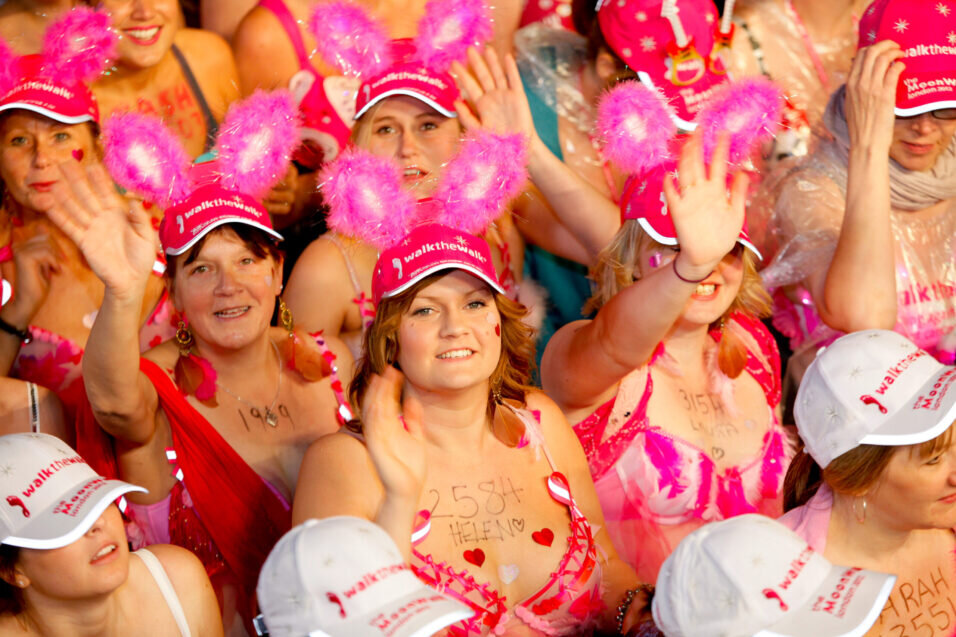How does Walk the Walk raise funds
There are a number of ways in which anyone can support Walk the Walk. As specialists in Walking and the associated health benefits it can give, we create sponsored Walking challenges of all distances and for all abilities. Whether it is for someone stepping out for the first time and aiming for 5K, or an ardent walker looking for a marathon or an ultra-challenge of 100 miles. Our aim is always to support and encourage everyone to become more active, a little fitter and no matter at what level they begin, to help them reach the Finish Line!
The MoonWalk London is our Flagship event, with similar challenges taking place in Scotland and Iceland, each one a unique experience. We also create treks and challenges in other parts of the world, as well as taking part in classic Marathons and challenges, both at home and in other countries.
But you don’t have to take on a challenge to support us, you can just make a donation for which we are always very grateful, Volunteers are invaluable to Walk the Walk and always very welcome, both helping out in the office, and at our MoonWalks.
You can sign up for monthly giving by making a donation each month no matter how small, it allows us the confidence to count on you. Or you could even give a lasting gift, by including us in your will.
We are always looking for charity partnerships with companies that support and reflect our ethos… Whichever way suits you, we could not do any of the wonderful things we have done, without the help of our supporters.
Our Goal
Walk the Walk are dedicated to raising money and awareness for vital breast cancer causes and to encourage women, men and children to start walking as a way of keeping fitter, healthier and as an important part of cancer prevention…
‘Our united aim is that no one should die from breast cancer’
Together with the Charity’s Trustees, all the proposals and applications received are carefully considered in order to ensure that they meet Walk the Walk’s policies and ethos. As a charity, we are committed to supporting research into breast cancer for the future health of us all, to help improve the lives of those who have cancer now, and for prevention. We now know that being active and eating well plays a key part in the prevention of breast cancer and other diseases, so we are passionate about encouraging women, men and children to start walking every day as a way of getting fitter and keeping well.
Where are our grants
See a map of all the areas where Walk the Walk grants have helped to make a difference.

Our ethos is twofold, firstly our Key Grants where we limit the number of organisations we support at any time, which enables us to make larger grants. In turn, this often means we can help charities to reach their aims more quickly. Secondly, we have a Community Grant where each year money is earmarked to grant to small community charities that are working on the front line of cancer.
Over the past 24 years, Walk the Walk has raised in excess of £137 million, much of which has been granted to support a wide variety of organisations across the UK. We have come a very long way in this time with research and our knowledge of breast cancer, but also treatments and diagnosis.
Whilst primary breast cancer, if detected early has every chance of being successfully treated, the same cannot be said for those with secondary cancer. Our focus is now firmly fixed on helping to fund research that will enable those with secondaries to have the same hope and choices, we all believe that nobody should die from breast cancer.
Emergency Grants
During this unprecedented time, acts of generosity such as yours will make a difference to those living with cancer. We are making £20,000 Emergency Grants every month to frontline cancer charities for the next 6 months to help them through this very difficult time. Find out more here.
Key Grants for Research
Over the last 24 years, more than £34 million has been granted to Breast Cancer Now to help support a range of very specific research studies.
These have included The Generations Study, which is following the lives of more than 113,000 women in the UK for 40 years. Also the Breast Cancer Now Tissue Bank, providing high quality tissue for research and the LEGACY Study, which allows patients with secondary breast cancer to donate their secondary cancer tissues for research, shortly after their death. Walk the Walk also funded the Nina Barough Pathology Laboratory at Breast Cancer Now’s Research Centre.
Most recently, Walk the Walk was the Principal Funder of the Walk the Walk Fellow and Breast Cancer Now Scientist, Dr Damir Varešlija, who is carrying out cutting edge research into secondary breast cancer spreading to the brain. We also contributed funding towards a year’s work carried out by specialised cross-centre teams at Breast Cancer Now’s Research Centre. Read more about Walk the Walk’s grants for research here.
Key grants for centres across the UK offering emotional and physical support for those living with cancer.
With more people surviving and living longer with cancer, integrated care now plays an important part in their journey through cancer and beyond. The emotional, physical and practical support that is offered in many of the centres around the UK has become an invaluable resource in helping people to live well with cancer.
Walk the Walk has always been very dedicated in its support of integrated care and sees it as an important part of recovery. Charities and organisations that we support include Penny Brohn UK, since 2000 we have granted in excess of £21.5 million to this organisation, to not only help fund a free service in its National Centre in Bristol, but to also support them in taking their services across the UK.
Grants from Walk the Walk have enabled Breast Cancer Haven to secure a firm footing at their London Centre and in turn allowed them to expand their services to reach more cancer patients in Leeds, Hereford and Wessex.
Maggie’s Centres started in Scotland and are now well known throughout the UK for the wonderful service they provide. All based in hospital grounds, Walk the Walk have granted in excess of £5 million to build a centre at Gartnavel in Glasgow and another at Larbert in the Forth Valley, plus contributed to a third in Airdrie.
Other Key grants across the UK
Walk the Walk has made a number of other key grants to help support the diagnosis of breast cancer and to improve the lives of those who have already been diagnosed with cancer.
Scalp Cooling helps cancer patients to keep their hair whilst undergoing their chemotherapy. It is not lifesaving but makes such a difference to the quality of life for many people. This is our own project and over the past 15 years, we set ourselves the ambitious task of removing the postcode lottery and ensuring that every cancer patient should be able to receive this treatment. We have granted in excess of £10 million to over 200 NHS Trusts. See more here.
At the Western General Hospital in Edinburgh, Walk the Walk contributed £5 million to fund a new breast cancer ward, a new operating theatre, and the renovation of the Mammography Unit. Together this has transformed not only the patient experience from breast checks through to treatment but also the working conditions for staff!
Tenovus is a Cardiff based charity that uses Mobile Cancer Support Units to take chemotherapy and lymphatic drainage to cancer patients living in the more rural areas of Wales. Walk the Walk has helped fund two of the units – read more about them here.
Leading Northern Ireland charity Action Cancer have been saving lives and supporting local people with cancer since the 1970’s. Walk the Walk is the Principal Funder of the charity’s new Big Bus, which will provide breast screening to women aged 40-49 and 70 and over, who fall outside the normal NHS screening range. Read more about the Big Bus here.
Community grants
Our Community Grants may be small but they are very effective in helping charities to fulfil their aims and provide some very special services to their local communities organisations.
Helen Rollason Cancer Charity in London provides support, counselling and complementary therapies to people living with cancer and their carers. Whilst The Christie in Manchester is home to the award-winning Complementary Therapy Unit, Walk the Walk was one of its founding funders.
Other beneficiaries include Maggie’s at Cancer Kin, based in the Royal Free Hospital in London and work closely with women in the east end of London and with those that need lymphatic drainage. FACT (Fighting All Cancers Together) is based in the North East and offering a fantastic service in an area where demand is high.
AUCS is a very different study for us to support but none the less important. Walk the Walk has funded a pilot study to look at the creation of a new and very much improved catheter.
Each year an amount of funding is set aside to support small charities that are having a big effect.
How to apply for a Walk the Walk Grant
If you are looking for a grant from Walk the Walk, then get in touch and we will advise you on the information you will need in order to present a grant request to our Trustees. Walk the Walk is about making a difference!
Charity accounts
These can be found here

